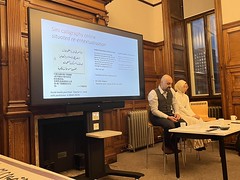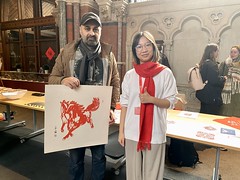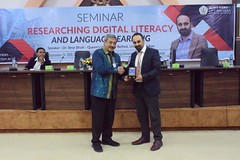This post follows a previous post (Beyond A4, part 1) and is based on the notes to my lecture at the White Rose Doctoral Training Centre annual Spring conference at the University of York. The lecture was entitled ‘Beyond A4: PhDs writing for multiple audiences’.
Disruptions
Whilst academic publishing is arguably still in the middle of its big digital disruption and overhaul, and various perspectives to this are being addressed as part of this event today, my talk is about another disruption facing academic professional work, much of which is exemplified in academics’ writing and knowledge creating activities. Academic publishing is of course one important part of this process, usually the end part, the glossed and polished written pieces of published work. But let us also not forget the messy, ephemeral, and often elided bits of work that goes into those end products.
So here I present some of my own reflections and experiences as a recent PhD graduate on the subject of writing for different audiences. I will focus on what we could describe as going ‘beyond A4’. But before I do that it is important to remind ourselves of the importance of writing in the enterprise of Higher Education and its importance in the life of a PhD student – which is a kind of apprenticeship into the academic life.
Academics’ work
PhD researches – like many people working in academia – spend a substantial proportion of their time writing, although we may not always describe some of our activities as ‘writing’. These can include routine and everyday writing activities, as opposed to more prestigious or scholarly forms of writings. But nevertheless all these practices form part of the dynamics of our knowledge creation, and integral constituents of academic practice.
The PhD as an apprenticeship is a powerful way of becoming acquainted with the demands of writing in the academic world (proposal writing, theses, conference papers, publications, etc.), but more recently newer forms of writing and engaging through social media have emerged which have in turn changed the nature of academic work and, subsequently, the nature of the doctoral experience. As a result of social media, academics’ work has become more diverse, changing the nature of research, scholarship, teaching, and public engagement.
Since the principal role of an academic, and this includes PhDs, is to produce, shape and distribute knowledge, how social media is then incorporated into this practice becomes an important challenge. Writing of many different kinds is central to this endeavour, but one particular dimension to these practices of writing, that which I’m going to call ‘beyond A4’ (or going beyond the formal mechanisms of the academy), is what the focus is here. So I will share some my own reflections in getting to grips with ‘beyond A4’, what its affordances are, and what this can mean for the future of academic knowledge production.
The Coffeehouse
We can draw upon the historical example of the coffeehouse both as an example and a metaphor for what can be described as ‘beyond A4’.
The coffeehouse, up to and during the Age of Enlightenment, provides a useful historical example of what can be achieved in the forums and arenas outside of the strictures of the academy. The coffee house helped foster a new spirit of the Enlightenment across Europe in the 17th century. This is because as people sipped on this new stimulant beverage from the Middle East within a forum such as the coffeehouse, they were thus encouraged to engage in free discussion, argue, maybe even fight about arts, politics, science, philosophy etc. away from the strictures of the academy, its seminar room, lecture theatre, etc. The point is that it was a much freer forum for people to develop networks, exchange information, and have access to ideas, not just through the range of people present from different social strata, but also the through the articles and literature present in the coffeehouse. Historians such as Dorinda Outram, situate coffeehouses of that time as part of a number of public intellectual spheres, allowing for the transfusion of enlightened ideas by bringing different social strata together to be exposed to them. Ideas were produced and marketed. There was a certain kind of assemblage of people and things: something I discuss extensively in my research on student writing. An assemblage of people (from various professions and movements) and things (coffee, as a stimulant provided an occasional alternative to the other beverage of the time, alcohol and literature), and literacy practices which ensued as a result of the new assemblage.
A similar kind of transfusion of ideas that occurred through Gutenberg and the onset of print culture, which lead to the ‘reading revolution’ and new kinds of employment, if also rendering obsolete other forms of employment (such as being a scribe). Taken together, these arenas and arrangements provided public space to ideas and debates beyond the institutions (political or academic) that had traditionally contained them.
This is because the coffeehouse provided a forum for the collision of ideas. And the link between what the coffeehouse afforded the transfusion of ideas in the Enlightenment period and what social media use offers academia is worth pondering over. That’s the link that I’m trying to make.
The Web
This brings me to the Web. The Internet as we know it was invented for scholars to communicate with one another; such was the conception of Tim Berners Lee in 1990. During that time, the kind of communication afforded by the Web was limited to the sharing of scholarly works via email. Then, by around 2005, blogging emerged as convenient way of having conversations online with minimal knowledge of HTML, and academics began to take seriously the idea of writing publicly and for an audience beyond their immediate circle of disciplinary peers. With this in mind, when Twitter was launched it was dubbed a ‘micro-blogging’ method of doing the very same thing except with fewer words, more speed, and to a wider audience. It has, therefore, and alongside other social media platforms allowed for the emergence of the ‘digitally networked scholar’ and serves for many of these digitally networked scholars as a crucial mechanism for knowledge creation and the collision of ideas – the kinds of collisions of ideas that characterised the coffeehouse centuries earlier.
Remember also that Tim Berners Lee’s original paper for the Web was rejected upon review and pushed down to the level of a poster in a 1991 conference. There are some arenas where great ideas get sidelined, and sometimes the ‘A4 space’ (i.e. academia’s formal space) is not ready to receive what you have to say. In this respect, it is in the best interests of PhDs to have a prepared mind to both communicate knowledge beyond the A4 space and to receive its good ideas. See Amy Collier’s post on ‘Not-Yetness‘.
Blogging
Later, blogging became a convenient tool for public thinking, and for academics to converse and disseminate ideas beyond their immediate disciplinary peers.
Half-baked ideas can and even should be recorded. they can even be shared; take for example Charles Darwin’s notes. Darwin converged upon his theory of natural selection in October 1838. But his notebooks, which obviously predate his conclusions, are full with annotations that point to how he got to his conclusion. This is important because Darwin’s discovery in reality was a synthesis of prior ideas, some of which were seemingly unimportant in isolation. You can read more about this kind of thing from Stephen Johnson’s book ‘Where Good ideas come from‘.
Blogging is a useful platform to share those kinds of ideas and engage in a form of public thinking; a way of developing ideas and seeking engagement with others before you formalise your ideas into a more traditional academic piece. Bearing in mind the multiplicity of potential audiences you will encounter and the ways your readers can respond to the material you present.
Then you need to think about what you post, and what your posts actually represent, and whether they are a kind of working papers. You may also need to check with publishers about using and citing elements of your own public thinking in later work. One way is to use your personal website to publish an early draft of something as a working paper, and then point to the final journal version (with a DOI link) when it eventually appears. It is your stuff after all. A pre-print author version of a paper will not have page numbers and all the formatting but is still able to be cited if you want/allow. It just needs to be stated as such.
The formal mechanisms remain something that are squarely within the A4 space, but there’s a parallel space ‘beyond A4’ where it is well worth being active, and I think you can play about in both. Your blog then is like an academic honey pot: people from various social strata will flock towards it to benefit from what you have to say, your insights, etc.
And if you always remain within formal mechanisms in terms of knowledge production, you may be robbing yourself of what others are doing in those other spaces, and what people are puzzling over beyond the academy. It depends on the army of people you are following, the personal learning network that you have developed. And of course, having a prepared mind. Academia teaches us to focus – and that’s a good thing – but in focussing, we could train our minds to ignore what’s outside the academy.
To be concluded with part 3.
Categories: academia, impact, Lectures, PhD Reflections, writing












According to my background, being new to blogging, your presentation makes sense for me – thank you for posting this. It is important for early career researchers and Phd students to practice blogging as a step towards public engagement. I was wondering, what about non-academic public? How can this informal, less institutionalized knowledge engage the public? How can we use blogging to discuss and create knowledge with the public and engaging them with us academics?
In your prezi, you mentioned links where the focus is on IMPACT. Coffee- houses are for the ordinary people where they gather from different backgrounds to discuss current hot issues in their local space and beyond their boundaries.
Blogging is like the coffee- house where academics write in a less formal way to ascend from their ivory towers and make contact with the ordinary people and create impact, change and plan for social transformation together. There are informal literacy practices that can engage the public more than excellently written A4 papers. For example, a rap singer produced a video and published on YouTube criticizing school curriculum, knowledge and mainstream pedagogies. This form of non-institutionalised digital practice ignites heated debates on social media (facebook, twitter and Youtube) and was viewed by thousands of people. The rap singer identity and digital production was very close to the public from different age groups. I wrote a simple piece on this:
http://maryamalmohammadspace.com/2015/05/11/what-is-resistance/
The metaphor of the coffee-shop is good. However, academics need to engage with the non-academics in the coffee-shop and adopt an identity, like the rap singer, which is close to them and their daily language. For example, in Syrian and Egyptian traditions, coffee shops used to be places to discuss current social, political, and economic conditions of their countries. The narrator or (Alhakawati in Arabic) is an outstanding figure in the coffee-shop where his profession (as a worker in the coffee-shop, and an artists or narrator of oral literature) was highly regarded and respected by people. Alhakawati narrates stories called in Arabic (siyar), where it indirectly critique the social, political, and economic practices in the country. An academic to be close to the public can draw on the identity and language of the narrator to produce knowledge close and relevant to the public.
In the Levant (Syria, Palestine, Jordan, and Lebanon), popular local siyar (stories) were performed before the ottoman Khilafa (before the 16th century) in front of mosques and in the public hammam (public baths), streets and squares and men social gatherings in the evening. The narrator used to sit on a raised seat wearing a traditional outfit. Traditional music and songs might be performed as well. After the sixteenth and the seventeenth century, the sirya were narrated in the ordinary simple coffee-houses for the common people. According to Arabic literature and European travellers resources, “ample evidence of the style of these coffee-houses narrator, who performed the siyar into the 1960s in Syria and Egypt” exists (source, Medieval Oral Literature, Karl Reichl, p.639).
In the past it was only for men where they sit, sip their coffee or tea, have shisha and listen to stories from ALHAKAWATI (the narrator) that has wisdom in them in relation to the political social and economic situation facing the country like occupation. The stories (siyar usually well-written in an oral form to engage the attention of the listener. It is between modern standard and dialect. Blogging also adapt a language between academic and daily modern English to be close to the public.
See the link below about a coffee shop in Syria. This is a coffee shop. The photos are recent where you find a mix of men and women because it becomes like traditional tourist entertainment practice. The narrator might be speaking about two real famous figures in Arabic literature ( a poet and his beloved for example) but then he will code-switch from Modern Standard and dialect to a foreign language. The purpose of this unexpected transligual practice is to entertain the tourist who are setting to listen to a story of classic figures in Arab literature before Islam era and then they got surprised and laugh when they hear the poet saying a phrase in Engish or German to his beloved:
http://www.syr-res.com/article/3577.html
The language and the musical rhymes of the narrator usually attracts the attention of men like it does attract the attention of a little child when his mom tells a story. If you drop a needle you can hear it ring. You can read a very deep description of the coffee-houses near Barada river in Damascus in Ukers Williams’ book “All About Coffee”:
The only intellectual gratification in these places is afforded by the Arab-story tellers {…} among whom are few eminent and clever men: soon after his entrance, a group begins to form around the gifted man, who, after a suitable pause to collect hearers or whet their expectations, begins his story. It is a picturesque sight – of the Arab with his wild and graceful gestures, and his auditory, hushed into deep and child-like attention, seated at the edge of the rushing tide while the narrator moves from side to side and each accent of his distinct and musical voice is heard throughout the Café (Williams, P. 461).
You can see such scenes in Syrian drama. This is a Syrian social drama called Maraya (Mirrors). Maraya 1999 is called Hakawati Alhara (The narrator of the neighborhood). It was around stories narrated by Alhakawati which is usually in a coffee-shop where only men listen and discuss issues. This series selects traditional houses as the scene where the narrator tells his stories to family members and friends both men and women sitting together. The producer and actor critique social and political practices in Syria a very creative way. All stories are written by him. He is called Yaser Al-Adma. Here is an episode about a ruler in the past and how his wife was advising him not to be an oppressor and he changes to be the most just ruler.
An academic to be close to the public in the coffee-shop need to change his identity to be closer to the public like the narrator. Although the language is still sophisticated and follows rhymes and unexpected code-switching and other techniques but still it is oral literature close to the public. This oral literature has been studied in Arabic literature by both Arab and non-Arab speakers.
How academic blogs and identities can make use of the coffee-house and narrator metaphors in their use of language and scenes to engage the public beyond virtual blogging? – To achieve real impact & draw attention to current problems.